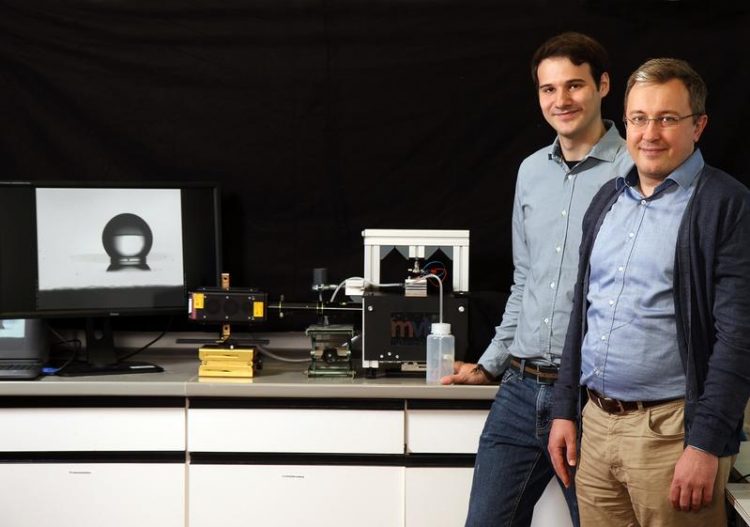Achema 2018: Researchers take a closer look at drops using 3D high-speed camera technology

Fabian Krull (left) and Professor Sergiy Antonyuk ) are investigating what happens when drops hit difference surfaces. Credit: TUK/Thomas Koziel
During the Achema, a trade fair for the process industries in Frankfurt, they are presenting this technology at the research stand of the federal state Rhineland-Palatinate from June 11-15 (hall 9.2, stand A86a).
If drops of water fall on a lotus leaf, they simply roll off. This phenomenon, also known as “lotus effect”, is based on the fact that the surface of those leafs shows unevenness (nubs) which in the end makes the drop roll off. The tiny structures were discovered by the botanist Wilhelm Barthlott in the 1970s thanks to a scanning electron microscope. The very same principle is now used for window glass or wall paint.
Researchers of the Department Mechanical and Process Engineering at the TU Kaiserslautern engage in this this phenomenon. They investigate the behavior of drops when they encounter surfaces which provide differently formed micro structures, such as nubs, grid or trapezoid.
“Here we deal with structures that are significantly smaller than the diameter of a hair, for example,” says Fabian Krull, who investigates this topic within the scope of his doctorate at the Department of Particle Process Engineering of Professor Dr. Sergiy Antonyuk. They are in a range of 100 nanometer and 10 micrometer; dimensions not visible to the human eye. And still those structures can influence the impingement of drops on a surface in different ways.
In order to be able to observe this process in detail, three high-performance cameras are used. “They take pictures from different angles”, says Fabian Krull. Software is used to then convert the data to a 3D picture. “That way we can observe step by step what happens when a drop hits different surfaces”, explains Professor Antonyuk. Furthermore, the engineers simulate the fall of those drops with their computer models.
Research is carried out within the framework of the Collaborative Research Centre 926 “Component Surfaces: Morphology on a microscale”, which is subsidized by the German Research Foundation. The researchers' findings might be able to help reduce friction of machines or design surfaces of industrial plants to prevent dust and contamination particles to accumulate on the machines. This would also be useful for hospitals so that microorganisms cannot adhere to certain things.
The engineers are presenting their camera system and research work at the Achema.
Questions can be directed to:
Prof. Sergiy Antonyuk
Phone: +49 (0) 631 205-3524
Email: sergiy.antonyuk(at)mv.uni-kl.de
Klaus Dosch, Department of Technology and Innovation, is organizing the presentation of the researchers of the TU Kaiserslautern at the fair. He is the contact partner for companies and, among other things, establishes contacts to science.
Contact: Klaus Dosch, Email: dosch[at]rti.uni-kl.de, Phone (also during the fair): +49 (0) 631 205-3001
Media Contact
All latest news from the category: Trade Fair News
Newest articles

A ‘language’ for ML models to predict nanopore properties
A large number of 2D materials like graphene can have nanopores – small holes formed by missing atoms through which foreign substances can pass. The properties of these nanopores dictate many…

Clinically validated, wearable ultrasound patch
… for continuous blood pressure monitoring. A team of researchers at the University of California San Diego has developed a new and improved wearable ultrasound patch for continuous and noninvasive…

A new puzzle piece for string theory research
Dr. Ksenia Fedosova from the Cluster of Excellence Mathematics Münster, along with an international research team, has proven a conjecture in string theory that physicists had proposed regarding certain equations….



